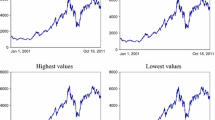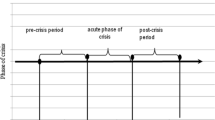Abstract
We examine the behavior of stock market prices in several African countries by means of fractionally integrated techniques. In doing so, we can test for mean reversion in these markets. Our results can be summarized as follows: we cannot find evidence of mean reversion in any single market, and evidence of long memory returns (i.e., orders of integration above 1 in the logged stock prices) is obtained in the cases of Egypt and Nigeria, and, in a lesser extent in Tunisia, Morocco and Kenya. Permitting the existence of a structural change, the break dates take place in the earlier 2000s in the majority of the cases, and evidence of mean reversion seems to have taken place in the periods before the breaks in most of the countries. If we focus on the absolute and squared returns, evidence of long memory is obtained in Nigeria and Egypt. Thus, for these two countries, a long memory model incorporating positive fractional degrees of integration in both the level and the volatility process should be considered.
Similar content being viewed by others
Notes
We thank Paul Alagidede and Theodore Panagiotidis for kindly providing the dataset.
In what follows, we assume that \( {\left( {1 - {\hbox{L}}} \right)^{{{\rm{d}}_{\rm{i}}}}}{{\hbox{y}}_{\rm{t}}} = {\widetilde{1}_{\rm{t}}}\left( {{{\hbox{d}}_{\rm{i}}}} \right) = \widetilde{\hbox{t}}\left( {{{\hbox{d}}_{\rm{i}}}} \right) = 0, \) for t ≤ 0. This is a standard assumption in the applied work, and is related with the Type II definition as opposed to the Type I definition of fractional integration. (See, Robinson and Marinucci 2001).
References
Alagidede P, Panagiotidis T (2009) Modelling stock returns in Africa’s emerging equity markets. Int Rev Financ Analy 18:1–11
Assaf A (2006) Dependence and mean reversion stock price: the case of the MENA region. Res Int Bus Finance 20(3):286–304
Barkoulas JT, Baum CF (1996) Long term dependence in stock returns. Econ Lett 53:253–259
Barkoulas JT, Baum CF, Travlos N (2000) Long memory in the Greek stock market. Appl Financ Econ 10:177–184
Cheung Y-W, Lai KS (1995) A search for long memory in international stock market returns. J Int Money Financ 14:597–615
Crato N (1994) Some international evidence regarding the stochastic behaviour of stock returns. Appl Financ Econ 4:33–39
Dahlhaus R (1989) Efficient parameter estimation for self-similar process. Ann Stat 17:1749–1766
Dickey DA, Fuller WA (1979) Distribution of the estimators for autoregressive time series with a unit root. J Am Stat Assoc 74:427–431
Diebold FX, Inoue A (2001) Long memory and regime switching. J Econom 105:131–159
Fama EF, French KR (1988) Permanent and transitory components of stock prices. J Polit Econ 96:246–273
Gil-Alana LA (2000) Fractional integration in the purchasing power parity. Econ Lett 69:285–288
Gil-Alana LA (2006) Fractional integration in daily stock market returns. Rev Financ Econ 15:28–48
Gil-Alana LA (2008) Fractional integration and structural breaks at unknown periods of time. J Time Ser Anal 29:163–185
Gil-Alana LA, Robinson PM (1997) Testing of unit roots and other nonstationary hypotheses in macroeconomic time series. J Econom 80:241–268
Granger CWJ, Ding Z (1995a) Some properties of absolute returns. An alternative measure of risk. Ann Écon Stat 40:67–91
Granger CWJ, Ding Z (1995b) Stylized facts on the temporal and distributional properties of daily data from speculative markets. UCSD Working Paper
Granger CWJ, Hyung N (2004) Occasional structural breaks and long memory with an application to the S&P 500 absolute stock return. J Empir Finance 11:399–421
Harvey CR (1995) Predictable risk and returns in emerging markets. Rev Financ Stud 8:773–816
Henry OT (2002) Long memory in stock returns. Some international evidence. Appl Financ Econ 12:725–729
Kilic R (2004) On the long memory properties of emerging capital markets: evidence from Istanbul stock exchange. Appl Financ Econ 14:915–922
Koong CS, Tsui AK, Chang WS (1997) On tests for long memory in pacific basin stock returns. Math Comput Simul 43:445–449
Kwiatkowski D, Phillips PCB, Schmidt P, Shin Y (1992) Testing the null hypothesis of stationarity against the alternative of a unit root. J Econom 54:159–178
Magnusson M, Wydick B (2002) How efficient are Africa's emerging stock markets? J Dev Stud 38:141–156
Phillips PCB, Perron P (1988) Testing for a unit root in a time series regression. Biometrika 75:335–346
Poterba JM, Summers LH (1988) Mean reversion in stock prices: evidence and implications. J Financ Econ 22:27–59
Robinson PM (1994) Efficient tests of nonstationary hypotheses. J Am Stat Assoc 89:1420–1437
Robinson PM (1995) Gaussian semiparametric estimation of long range dependence. Ann Stat 23:1630–1661
Robinson PM, Marinucci D (2001) Narrow band analysis of nonstationary processes. Ann Stat 29:947–986
Sadique S, Silvapulle P (2001) Long-term memory in stock market returns. International evidence. Int J Financ Econ 6:59–67
Sowell F (1992) Maximum likelihood estimation of stationary univariate fractionally integrated time series models. J Econom 53:165–188
Tolvi J (2003) Long memory and outliers in stock market returns. Appl Financ Econ 13:495–502
Author information
Authors and Affiliations
Corresponding author
Additional information
The second-named author gratefully acknowledges financial support from the Ministerio de Ciencia y Tecnologia (ECO2008-03035 ECON Y FINANZAS, Spain) and a PIUNA project from the University of Navarra. Comments of an anonymous referee are gratefully acknowledged. This paper belongs to a group of papers that will be discussed at the Navarra Center for International Development (NCID) at the University of Navarra.
Appendix
Appendix
The Lagrange Multiplier (LM) test of Robinson (1994) for testing Ho: d = d o, in the model given by the Eqs. 1 and 2 is
where T is the sample size and:
\( \widehat{\hbox{a}} \) and \( \widehat{\hbox{A}} \) in the above expressions are obtained through the first and second derivatives of the log-likelihood function with respect to d (see Robinson 1994, page 1,422, for further details). I(λ j) is the periodogram of u t evaluated under the null, i.e.:
where z t = (1, t)T, and g is a known function related to the spectral density function of u t:
Rights and permissions
About this article
Cite this article
Anoruo, E., Gil-Alana, L.A. Mean reversion and long memory in African stock market prices. J Econ Finan 35, 296–308 (2011). https://doi.org/10.1007/s12197-010-9124-0
Published:
Issue Date:
DOI: https://doi.org/10.1007/s12197-010-9124-0




